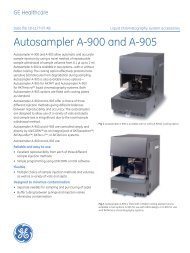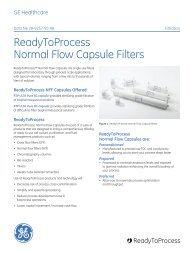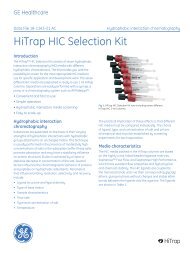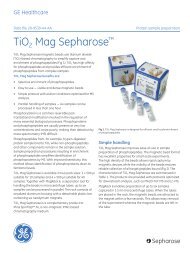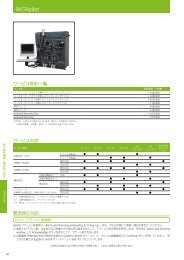[PDF] Data file: HiLoad Superdex prep grade
[PDF] Data file: HiLoad Superdex prep grade
[PDF] Data file: HiLoad Superdex prep grade
You also want an ePaper? Increase the reach of your titles
YUMPU automatically turns print PDFs into web optimized ePapers that Google loves.
GE Healthcare<br />
Life Sciences<br />
<strong>Data</strong> <strong>file</strong> 18-1100-52 AE<br />
Gel filtration<br />
<strong>HiLoad</strong> <strong>Superdex</strong> 30 <strong>prep</strong> <strong>grade</strong><br />
<strong>HiLoad</strong> <strong>Superdex</strong> 75 <strong>prep</strong> <strong>grade</strong><br />
<strong>HiLoad</strong> <strong>Superdex</strong> 200 <strong>prep</strong> <strong>grade</strong><br />
<strong>HiLoad</strong> columns are XK laboratory columns <strong>prep</strong>acked with<br />
<strong>Superdex</strong> <strong>prep</strong> <strong>grade</strong> for gel filtration. <strong>Superdex</strong> <strong>prep</strong> <strong>grade</strong><br />
is a matrix of dextran and highly cross-linked agarose. The<br />
steep selectivity of the dextran component and the high<br />
chemical and physical stability of the agarose give high<br />
resolution separations at flow rates up to 50 cm/h.<br />
<strong>HiLoad</strong> columns offer a number of significant advantages<br />
for high resolution work:<br />
• Prepacked for convenience and reproducibility<br />
• High-resolution separation of biomolecules<br />
• High chemical stability and easy scale-up<br />
• Easy connection to chromatography systems, such as<br />
ÄKTA design<br />
Three types of <strong>Superdex</strong> <strong>prep</strong> <strong>grade</strong> are available in <strong>prep</strong>acked<br />
<strong>HiLoad</strong> columns: <strong>Superdex</strong> 30 <strong>prep</strong> <strong>grade</strong>, <strong>Superdex</strong> 75 <strong>prep</strong><br />
<strong>grade</strong>, and <strong>Superdex</strong> 200 <strong>prep</strong> <strong>grade</strong>. All are <strong>prep</strong>acked to<br />
600 mm bed heights in 16 mm or 26 mm diameter columns.<br />
Each column is expertly packed and individually tested. This<br />
combination of <strong>prep</strong>acked convenience and reproducibility<br />
make <strong>HiLoad</strong> <strong>Superdex</strong> <strong>prep</strong> <strong>grade</strong> columns a confident choice<br />
for fast, high-resolution gel filtration at <strong>prep</strong>arative scale.<br />
The columns run with a wide variety of equipment, including<br />
simple pump-based configurations and ÄKTA design systems.<br />
<strong>Superdex</strong> gel filtration media are produced by the covalent<br />
binding of dextran to highly cross-linked porous agarose beads.<br />
Fig 1. <strong>HiLoad</strong> <strong>Superdex</strong> 30, 75, and 200 <strong>prep</strong> <strong>grade</strong> columns bring<br />
convenience and high resolution to gel filtration. Each is available in two<br />
column sizes, <strong>HiLoad</strong> 16/600 and <strong>HiLoad</strong> 26/600.<br />
Steep selectivity curves give unmatched resolution for<br />
biomolecules in the molecular weight range up to 10 000<br />
for <strong>Superdex</strong> 30 <strong>prep</strong> <strong>grade</strong> (Fig 1), 3000 to 70 000 for<br />
<strong>Superdex</strong> 75 <strong>prep</strong> <strong>grade</strong>, and 10 000 to 600 000 for<br />
<strong>Superdex</strong> 200 <strong>prep</strong> <strong>grade</strong> (Fig 2).<br />
Moreover, the mean particle size of 34 µm and narrow particle<br />
size distribution of <strong>Superdex</strong> <strong>prep</strong> <strong>grade</strong> media give good<br />
separation performance without creating high backpressure.<br />
imagination at work
K av<br />
0.7<br />
0.6<br />
0.5<br />
0.4<br />
0.3<br />
0.2<br />
0.1<br />
<strong>Superdex</strong> 30 pg<br />
PEG<br />
peptides<br />
Column: <strong>HiLoad</strong> 26/600 <strong>Superdex</strong> 30 <strong>prep</strong> <strong>grade</strong><br />
Sample: 50 µl mix of five synthetic peptides in 1% TFA<br />
1: M r<br />
3 894<br />
2: M r<br />
3 134<br />
3: M r<br />
2 365<br />
4: M r<br />
1 596<br />
5: M r<br />
827<br />
Buffer: 20 mM Tris-HCl, 0.25 M NaCI, pH 8.5<br />
Flow rate: 1 ml/min (30 cm/h)<br />
A 280 nm<br />
0.005<br />
80<br />
1<br />
TF A<br />
2 3<br />
4 5<br />
300 1000 10 000 M r<br />
K av<br />
0.8<br />
0.6<br />
0.4<br />
75 pg<br />
200 pg<br />
<strong>Superdex</strong> 75 pg<br />
<strong>Superdex</strong> 200 pg<br />
Dextrans<br />
0 160 240 320<br />
Volume (ml)<br />
Fig 3. Separation of test substances on <strong>HiLoad</strong> 26/600 <strong>Superdex</strong> 30 <strong>prep</strong> <strong>grade</strong>.<br />
<strong>Superdex</strong> 30 <strong>prep</strong> <strong>grade</strong> is optimized for proteins/peptides below M r<br />
10 000.<br />
0.2<br />
K av<br />
0.8<br />
0.6<br />
0.4<br />
10 4 10 5 10 6 10 7 M r<br />
75 pg<br />
<strong>Superdex</strong> 75 pg<br />
<strong>Superdex</strong> 200 pg<br />
200 pg<br />
Globular<br />
proteins<br />
Columns: A) <strong>HiLoad</strong> 16/600 <strong>Superdex</strong> 75 <strong>prep</strong> <strong>grade</strong><br />
B) <strong>HiLoad</strong> 16/600 <strong>Superdex</strong> 200 <strong>prep</strong> <strong>grade</strong><br />
Sample: 1. Myoglobulin, 1.5 mg/ml, M r<br />
17 000<br />
2. Ovalbumin, 5 mg/ml, M r<br />
44 000<br />
3. Albumin, human 5 mg/ml, M r<br />
66 000<br />
4. IgG, 0.2 mg/ml, M r<br />
158 000<br />
5. Ferritin, 0.24 mg/ml, M r<br />
440 000<br />
Sample volume: 500 µl<br />
Buffer:<br />
0.010 M phosphate buffer 0.14 M NaCl, 0.0027 M KCl, pH 7.4 (PBS)<br />
Flow rate: 1 ml/min (30 cm/h)<br />
A)<br />
mAU<br />
1500<br />
1250<br />
<strong>HiLoad</strong> 16/600<br />
3 2<br />
<strong>Superdex</strong> 75 <strong>prep</strong> <strong>grade</strong><br />
0.2<br />
1000<br />
750<br />
4 and 5<br />
10 4 10 5 10 6 10 7 M r<br />
500<br />
1<br />
Fig 2. Selectivity curves from <strong>Superdex</strong> 30 pg, <strong>Superdex</strong> 75 pg, and<br />
<strong>Superdex</strong> 200 pg.<br />
Figures 3 and 4 show separations of different model proteins<br />
on <strong>HiLoad</strong> 16/600 <strong>Superdex</strong> 30 pg, 75 pg, and 200 pg.<br />
Table 1 summarizes the characteristics of the media and<br />
columns.<br />
B)<br />
250<br />
0<br />
mAU<br />
1250<br />
1000<br />
750<br />
40 50 60 70 80 60<br />
Time (min)<br />
<strong>HiLoad</strong> 16/600<br />
<strong>Superdex</strong> 200 <strong>prep</strong> <strong>grade</strong><br />
3<br />
2<br />
500<br />
1<br />
4<br />
250<br />
5<br />
0<br />
40 50 60 70 80 90 100<br />
Time (min)<br />
Fig 4. Comparison of the selectivity of <strong>Superdex</strong> 75 <strong>prep</strong> <strong>grade</strong> and<br />
<strong>Superdex</strong> 200 <strong>prep</strong> <strong>grade</strong> for model proteins. <strong>Superdex</strong> 75 <strong>prep</strong> <strong>grade</strong> (A) gives<br />
excellent resolution of the three proteins in the M r<br />
range 17 000 to 67 000<br />
while the two largest elute together in the void volume. <strong>Superdex</strong> 200<br />
<strong>prep</strong> <strong>grade</strong> (B) resolves these two largest proteins. The ferritin (5) contains<br />
aggregates and thus results in a double peak.<br />
2 18-1100-52 AE
Table 1. Characteristics of <strong>HiLoad</strong> <strong>Superdex</strong> 30 <strong>prep</strong> <strong>grade</strong>,<br />
<strong>HiLoad</strong> <strong>Superdex</strong> 75 <strong>prep</strong> <strong>grade</strong> and <strong>HiLoad</strong> <strong>Superdex</strong> 200 <strong>prep</strong> <strong>grade</strong>.<br />
Matrix<br />
Dextran covalently bound to highly<br />
cross-linked agarose<br />
Average particle size 34 µm<br />
Separation range (M r<br />
) < 10 000 (<strong>Superdex</strong> 30 pg)<br />
globular proteins 3 × 10 3 –7 × 10 4 (<strong>Superdex</strong> 75 pg)<br />
1 × 10 4 –6 × 10 5 (<strong>Superdex</strong> 200 pg)<br />
dextrans<br />
5 × 10 2 –3 × 10 4 (<strong>Superdex</strong> 75 pg)<br />
1 × 10 3 –1 × 10 5 (<strong>Superdex</strong> 200 pg)<br />
Column volume 120 ml (<strong>HiLoad</strong> 16/600)<br />
320 ml (<strong>HiLoad</strong> 26/600)<br />
Sample volume Up to 5 ml (<strong>HiLoad</strong> 16/600)<br />
Up to 13 ml (<strong>HiLoad</strong> 26/600)<br />
Recommended flow rate 10–50 cm/h at room temperature<br />
(0.3–1.6 ml/min for <strong>HiLoad</strong> 16/600,<br />
0.9–4.4 ml/min for <strong>HiLoad</strong> 26/600)<br />
Theoretical plates >13 000 m -1<br />
Maximum pressure<br />
over the packed bed<br />
during operation, ∆p 1 0.3 MPa, 3 bar, 42 psi<br />
<strong>HiLoad</strong> column hardware<br />
pressure limit<br />
0.5 MPa, 5 bar, 73 psi<br />
Column fittings<br />
1/16” (valco)<br />
pH stability<br />
long term and<br />
working range 3 to 12<br />
short term 1 to 14<br />
Solutions in which the<br />
media is stable<br />
Storage<br />
<strong>Superdex</strong> 30 <strong>prep</strong> <strong>grade</strong><br />
<strong>Superdex</strong> 75 <strong>prep</strong> <strong>grade</strong><br />
All commonly used aqueous buffers,<br />
pH 3–12<br />
1 M acetic acid<br />
1 M sodium hydroxide<br />
8 M urea<br />
6 M guanidine hydrochloride<br />
30% isopropanol<br />
30% acetonitrile<br />
70% ethanol<br />
0.2 M sodium acetate in 20% ethanol<br />
at 4°C to 30°C<br />
0.2 M sodium acetate in 20% ethanol<br />
at 4°C to 30°C<br />
<strong>Superdex</strong> 200 <strong>prep</strong> <strong>grade</strong> 20% ethanol at 4°C to 30°C<br />
The media also withstand the rigorous conditions used in<br />
process hygiene procedures such as sanitization. All strong<br />
oxidizing agents should, however, be avoided.<br />
Extensive studies, including long-term exposure to harsh<br />
chemical treatment, have demonstrated that <strong>Superdex</strong><br />
<strong>prep</strong> <strong>grade</strong> has extremely high chemical stability. Figure 5<br />
illustrates the long-term stability of <strong>Superdex</strong> 200 <strong>prep</strong> <strong>grade</strong><br />
to 0.1 M HCl and 1 M NaOH, a feature that is important for<br />
CIP procedures.<br />
Nonspecific interaction<br />
Studies have demonstrated varying degrees of nonspecific<br />
interaction between the chromatography media and<br />
acidic, as well as basic proteins in the absence of salt. Such<br />
interactions are negligible in salt concentrations between<br />
0.15–1.5 M NaCl.<br />
A)<br />
K av<br />
1.0<br />
0.5<br />
0.4<br />
0.3<br />
0.2<br />
0.0<br />
0<br />
B)<br />
Accumulated exposure to 0.1 M HCl<br />
100 200 300 Time (h)<br />
K av<br />
1.0 Accumulated exposure to 1 M NaOH<br />
0.5<br />
0.4<br />
0.3<br />
0.2<br />
Cytidine<br />
Lysozyme<br />
Cytochrome C<br />
Myoglobin<br />
α-chymotrypsin A<br />
β-lactoglobulin<br />
Ovalbumin<br />
BSA<br />
IgG<br />
Ferritin<br />
1<br />
H 2<br />
O at room temperature<br />
0.0<br />
0<br />
100 200 300 Time (h)<br />
Chromatography media characteristics<br />
Chemical stability<br />
Chromatography media based on highly cross-linked<br />
agarose are very stable. Low sample volumes give high<br />
resolution even at high flow rates.<br />
<strong>Superdex</strong> 30 <strong>prep</strong> <strong>grade</strong>, <strong>Superdex</strong> 75 <strong>prep</strong> <strong>grade</strong>, and<br />
<strong>Superdex</strong> 200 <strong>prep</strong> <strong>grade</strong> may be used in aqueous<br />
solutions over the range pH 3 to 12 for continuous operation<br />
and over the range pH 1 to 14 for cleaning-in-place (CIP).<br />
Chaotropic agents such as 6 M guanidine hydrochloride or<br />
8 M urea, detergents (ionic and non-ionic), and polar organic<br />
solvents such as 70% ethanol can also be used for CIP.<br />
Fig 5. Performance of <strong>Superdex</strong> 200 <strong>prep</strong> <strong>grade</strong> measured as K av<br />
values<br />
of a protein mixture after repeated treatment with (A) 0.1 M HCl and<br />
(B) 1 M NaOH. The chromatography medium was exposed for repeated 8 h<br />
periods at temperature of 22°C. After each exposure period the K av<br />
value<br />
was determined for a test mixture of proteins. Following an accumulated<br />
exposure time of 150 h, the exposure periods were increased to 16 h.<br />
Even after more than 300 h accumulated exposure, K av<br />
values did not<br />
change significantly.<br />
18-1100-52 AE 3
Column characteristics<br />
The XK columns <strong>prep</strong>acked with <strong>Superdex</strong> <strong>prep</strong> <strong>grade</strong> media<br />
are easy to use laboratory columns. Each has a precision<br />
bore borosilicate glass tube and a fitted thermostatic jacket.<br />
Dead volumes make up less than 0.1% of the total column<br />
volume, keeping sample dilution and band broadening<br />
to a minimum.<br />
Valco fittings (1/16”) are standard and provide easy and<br />
direct connection to ÄKTA design systems.<br />
Every <strong>prep</strong>acked <strong>HiLoad</strong> column is tested for number of<br />
theoretical plates per meter (N/m), asymmetry factor (Af)<br />
and bed height (mm). These stringent control measures<br />
ensure that <strong>HiLoad</strong> columns give reproducible results time<br />
after time.<br />
Applications<br />
<strong>HiLoad</strong> <strong>Superdex</strong> 30 <strong>prep</strong> <strong>grade</strong><br />
<strong>HiLoad</strong> <strong>Superdex</strong> 30 <strong>prep</strong> <strong>grade</strong> is optimized for proteins<br />
and peptides (Fig 7), but it can also be used with success to<br />
separate oligosaccharides (Fig 6).<br />
Column:<br />
Sample volume:<br />
<strong>HiLoad</strong> 16/600 <strong>Superdex</strong> 30 <strong>prep</strong> <strong>grade</strong> (120 ml)<br />
1 ml<br />
Buffer: 0.05 M Tris-HCl, 1 M NaCl, 0.1% Triton X-100, pH 8.0<br />
Flow rate:<br />
A)<br />
B)<br />
10 -3 × 3 H (c.p.m.)<br />
10 -3 × 14 C (c.p.m.)<br />
10<br />
5<br />
20<br />
10<br />
1 ml/min (30 cm/h)<br />
19 17 15 13 11<br />
18 14<br />
16<br />
12<br />
10<br />
9<br />
8<br />
7<br />
6<br />
Column:<br />
<strong>HiLoad</strong> 16/600 <strong>Superdex</strong> 30 <strong>prep</strong> <strong>grade</strong> (120 ml)<br />
Sample:<br />
1 ml tryptic digest of human inter-α-inhibitor<br />
Buffer: PBS, 100 mM NaCl, pH 7.4<br />
Flow rate:<br />
1 ml/min (30 cm/h)<br />
Detection:<br />
UV, absorbance 220 nm<br />
A 220 nm<br />
0.5<br />
0.4<br />
0.3<br />
0.2<br />
0.1<br />
0<br />
0 10 20 30 40 50 60 70 80 90 100 110 120 130 140<br />
Time (min)<br />
Fig 7. Purification of tryptic digest of human inter-α-inhibitor using<br />
<strong>HiLoad</strong> 16/600 <strong>Superdex</strong> 30 <strong>prep</strong> <strong>grade</strong> resulted in seven separated peaks<br />
(I–VII). Pool I contains the large peptide fragment including the intact<br />
carbohydrate cross-link. The size of this fragment is mainly due to the<br />
large hydrodynamic volume of the GAG (glycosaminoglycan). Gel filtration<br />
is a good choice for isolating peptides containing large carbohydrate<br />
moieties. Reproduced by kind permission of Dr. J. Enghild, Dept. of<br />
Molecular and Structural Biology, University of Aarhus, Denmark.<br />
Column: <strong>HiLoad</strong> 16/600 <strong>Superdex</strong> 75 <strong>prep</strong> <strong>grade</strong> (120 ml)<br />
Sample: IGF-1, ZZ fusion protein and uncleaved material<br />
Buffer: 0.15 ammonium acetate, pH 6.0<br />
Flow rate: 0.75 ml/min (22.5 cm/h)<br />
A 280 nm<br />
0.1<br />
Pool 1<br />
I<br />
II<br />
III<br />
IV<br />
V<br />
<strong>HiLoad</strong> <strong>Superdex</strong> 75 <strong>prep</strong> <strong>grade</strong><br />
<strong>HiLoad</strong> <strong>Superdex</strong> 75 <strong>prep</strong> <strong>grade</strong> separates proteins and<br />
peptides in the molecular weight range, M r<br />
3000–70 000 and<br />
performs best between 8000 and 50 000 (Figs 8 and 9).<br />
VI<br />
VII<br />
0<br />
45 50 55 60 65 70 75 80<br />
Volume (ml)<br />
0.05<br />
V 0<br />
IGF-1<br />
V t<br />
Fig 6. Separation of oligosaccharides on <strong>HiLoad</strong> 16/600 <strong>Superdex</strong><br />
30 <strong>prep</strong> <strong>grade</strong>. The numbers above each peak indicate the number<br />
of monosaccharide units per molecule/chain. The oligosaccharides<br />
are applied one at a time. Each chromatogram represents seven<br />
superimposed analyses. Reproduced by kind permission of<br />
Dr. K. Lidholt, University of Uppsala, Sweden.<br />
0<br />
Fraction 1 2 3 4<br />
1.0 2.0 Time (h)<br />
Fig 8. Separation of recombinant IGF-1 (insulin-like growth factor 1, M r<br />
7600)<br />
from its fusion protein partner (ZZ, M r<br />
14 500) and uncleaved material.<br />
V 0<br />
= Column void volume. V t<br />
= Total column volume.<br />
4 18-1100-52 AE
Column:<br />
Sample:<br />
<strong>HiLoad</strong> 16/600 <strong>Superdex</strong> 75 <strong>prep</strong> <strong>grade</strong> (120 ml)<br />
2 ml endo-β-1,4-glucanase (cellulase) from blue mussel<br />
(Mytilus edilus). Concentrated, eluted endoglucanase active material<br />
from from an affinity step<br />
Buffer: 20 mM sodium phosphate buffer, 0.3 M NaCl, pH 7.0<br />
Flow rate:<br />
A 280 nm<br />
0.35<br />
0.3<br />
0.25<br />
0.2<br />
0.15<br />
0.1<br />
0.05<br />
1 ml/min (30 cm/h)<br />
280 nm<br />
endoglucanase activity<br />
0.8<br />
0.7<br />
0.6<br />
0.5<br />
0.4<br />
0.3<br />
0.2<br />
0.1<br />
Relative endoglucanase activity<br />
Columns:<br />
<strong>HiLoad</strong> <strong>Superdex</strong> 200 <strong>prep</strong> <strong>grade</strong><br />
Column volumes, V T<br />
: a) 120 ml (16/600)<br />
b) 320 ml (26/600)<br />
Sample:<br />
Mouse monoclonal cell supernatant, IgG 2b<br />
incl. 1% Fetal Calf Serum<br />
Sample pretreatment: Concentration ≈ 40× in concentration cell<br />
Sample volume: A) 1.2 ml<br />
B) 3.2 ml<br />
Buffer: 50 mM NaH 2<br />
PO 4<br />
, 0.15 NaCI, pH 7.0<br />
Flow rates:<br />
a) 1.6 ml/min (50 cm/h)<br />
b) 4.4 ml/min (50 cm/h)<br />
(max recommended flow rates)<br />
A)<br />
0.6<br />
0.4<br />
A 280 nm<br />
IgG 2b<br />
<strong>HiLoad</strong> 16/600<br />
<strong>Superdex</strong> 200 <strong>prep</strong> <strong>grade</strong><br />
0.0<br />
0.0<br />
0 20 40 60 80 100 120<br />
Volume (ml)<br />
Fig 9. Intermediate purification step in lab scale on <strong>HiLoad</strong> 16/60 <strong>Superdex</strong><br />
75 <strong>prep</strong> <strong>grade</strong>. Two ml concentrated sample of the endoglucanase<br />
active material eluted from an affinity step was applied on the column.<br />
Reproduced by kind permission of Dr. B. Xu, University of Uppsala, Sweden.<br />
B)<br />
0.2<br />
0<br />
0 20 40 60 80 Time (min)<br />
A 280 nm<br />
<strong>HiLoad</strong> <strong>Superdex</strong> 200 <strong>prep</strong> <strong>grade</strong><br />
Figure 10 shows the purification of mouse monoclonal IgG 2b<br />
0.6<br />
0.4<br />
IgG 2b<br />
<strong>HiLoad</strong> 26/600<br />
<strong>Superdex</strong> 200 <strong>prep</strong> <strong>grade</strong><br />
directly from cell supernatant. The reproducibility when<br />
scaling up from a <strong>HiLoad</strong> 16/600 to a <strong>HiLoad</strong> 26/600 column<br />
is also shown.<br />
<strong>HiLoad</strong> <strong>Superdex</strong> 200 <strong>prep</strong> <strong>grade</strong> has a separation range of<br />
M r<br />
10 000–600 000 and separates with highest selectivity<br />
between 30 000 and 250 000. <strong>Superdex</strong> 200 separates<br />
monoclonal antibodies from critical contaminants and<br />
aggregates (e.g., Fig 11).<br />
0.2<br />
0<br />
0 20 40 60 80 Time (min)<br />
Fig 10. Purification of mouse monoclonal IgG 2b<br />
from cell supernatant using<br />
A) <strong>HiLoad</strong> 16/600 <strong>Superdex</strong> 200 <strong>prep</strong> <strong>grade</strong>, column volume 120 ml and B)<br />
<strong>HiLoad</strong> 26/600 <strong>Superdex</strong> 200 <strong>prep</strong> <strong>grade</strong>, column volume 320 ml. Almost<br />
identical separations are the result, even using <strong>prep</strong>acked columns of<br />
different sizes.<br />
A)<br />
Column:<br />
Sample:<br />
Sample volume:<br />
Buffer:<br />
Flow rate:<br />
<strong>HiLoad</strong> 16/600 <strong>Superdex</strong> 200 <strong>prep</strong> <strong>grade</strong><br />
Monoclonal antibodies purified on HiScreen MabSelect SuRe LX<br />
1 ml<br />
0.010 M phosphate buffer, 0.14 M NaCl, 0.0027 M KCl, pH 7.4 (PBS)<br />
1 ml/min (30 cm/h)<br />
B)<br />
Column:<br />
Sample:<br />
Sample volume:<br />
Buffer:<br />
Flow rate:<br />
<strong>HiLoad</strong> 26/600 <strong>Superdex</strong> 200 <strong>prep</strong> <strong>grade</strong><br />
Monoclonal antibodies purified on HiScreen MabSelect SuRe LX<br />
3 ml<br />
0.010 M phosphate buffer, 0.14 M NaCl, 0.0027 M KCl, pH 7.4 (PBS)<br />
2.5 ml/min (28 cm/h)<br />
mAU<br />
400<br />
A) B)<br />
350<br />
300<br />
250<br />
200<br />
150<br />
Monomers<br />
mAU<br />
250<br />
200<br />
150<br />
100<br />
Monomers<br />
100<br />
20<br />
Aggregates/dimers<br />
50<br />
Aggregates/dimers<br />
0<br />
30 40 50 60 70 80 90<br />
Time (min)<br />
0<br />
80 100 120 140 160 180 200<br />
Time (min)<br />
Fig 11. Separation of monoclonal antibody monomers from aggregates/dimers on <strong>HiLoad</strong> 16/600 <strong>Superdex</strong> 200 <strong>prep</strong> <strong>grade</strong> and <strong>HiLoad</strong> 26/600<br />
<strong>Superdex</strong> 200 <strong>prep</strong> <strong>grade</strong>. 85% of IgG 4<br />
was monomers (9.5 mg).<br />
18-1100-52 AE 5
Ordering Information<br />
Product Quantity Code no.<br />
<strong>HiLoad</strong> 16/600<br />
<strong>Superdex</strong> 30 <strong>prep</strong> <strong>grade</strong> 1 × 120 ml 28-9893-31<br />
<strong>HiLoad</strong> 26/600<br />
<strong>Superdex</strong> 30 <strong>prep</strong> <strong>grade</strong> 1 × 320 ml 28-9893-32<br />
<strong>HiLoad</strong> 16/600<br />
<strong>Superdex</strong> 75 <strong>prep</strong> <strong>grade</strong> 1 × 120 ml 28-9893-33<br />
<strong>HiLoad</strong> 26/600<br />
<strong>Superdex</strong> 75 <strong>prep</strong> <strong>grade</strong> 1 × 320 ml 28-9893-34<br />
<strong>HiLoad</strong> 16/600<br />
<strong>Superdex</strong> 200 <strong>prep</strong> <strong>grade</strong> 1 × 120 ml 28-9893-35<br />
<strong>HiLoad</strong> 26/600<br />
<strong>Superdex</strong> 200 <strong>prep</strong> <strong>grade</strong> 1 × 320 ml 28-9893-36<br />
Accessories No. supplied Code no.<br />
Accessory kit XK 16* 28-9899-78<br />
Accessory kit XK 26* 28-9899-79<br />
Support screen XK 16 5 19-0651-01<br />
Support screen XK 26 5 18-9377-01<br />
Net ring (10 μm) XK 16 5 18-8761-01<br />
Net ring (10 μm) XK 26 5 18-8760-01<br />
O-ring XK 16 5 19-0163-01<br />
O-ring XK 26 5 28-9782-27<br />
Stop plug female, 1/16” 5 11-0004-64<br />
HiTrap/HiPrep 1/16” male<br />
connector for ÄKTA design 8 28-4010-81<br />
Transport device 1 18-1176-43<br />
Related products Quantity Code no.<br />
<strong>Superdex</strong> Peptide PC 3.2/30 1 × 2.4 ml 17-1458-01<br />
<strong>Superdex</strong> Peptide 10/300 GL 1 × 24 ml 17-5176-01<br />
<strong>Superdex</strong> 30 <strong>prep</strong> <strong>grade</strong> 150 ml 17-0905-01<br />
<strong>Superdex</strong> 75 PC 3.2/30 1 × 2.4 ml 17-0771-01<br />
<strong>Superdex</strong> 75 5/150 GL 1 × 3 ml 28-9205-04<br />
<strong>Superdex</strong> 75 10/300 GL 1 × 24 ml 17-5174-01<br />
<strong>Superdex</strong> 75 <strong>prep</strong> <strong>grade</strong> 150 ml 17-1044-01<br />
<strong>Superdex</strong> 200 PC 3.2/30 1 × 2.4 ml 17-1089-01<br />
<strong>Superdex</strong> 200 5/150 GL 1 × 3 ml 28-9065-61<br />
<strong>Superdex</strong> 200 10/300 GL 1 × 24 ml 17-5175-01<br />
<strong>Superdex</strong> 200 <strong>prep</strong> <strong>grade</strong> 150 ml 17-1043-01<br />
Related literature<br />
Code no.<br />
Gel Filtration, Principles and Methods 18-1022-18<br />
Gel Filtration Columns and Media, Selection Guide 18-1124-19<br />
Prepacked chromatography columns for<br />
ÄKTA design systems, Selection Guide 28-9317-78<br />
* Accessory kits XK 16 and XK 26 are suitable for repacking purposes and contain: 2 support screens,<br />
5 net rings , 2 O-rings, 2 stop plugs, 10 HiTrap/HiPrep 1/16” male connectors for ÄKTA design, and<br />
1 tool for dismantling.<br />
For local office contact information, visit<br />
www.gelifesciences.com/contact<br />
www.gelifesciences.com/protein-purification<br />
GE Healthcare Bio-Sciences AB<br />
Björkgatan 30<br />
751 84 Uppsala<br />
Sweden<br />
imagination at work<br />
GE, imagination at work, and GE monogram are trademarks of General Electric Company.<br />
ÄKTA, <strong>HiLoad</strong>, HiScreen, MabSelect SuRe, and <strong>Superdex</strong> are trademarks of GE Healthcare companies.<br />
All third party trademarks are the property of their respective owners.<br />
© 2006-2011 General Electric Company—All rights reserved.<br />
First published 2006.<br />
All goods and services are sold subject to the terms and conditions of sale of the company within<br />
GE Healthcare which supplies them. A copy of these terms and conditions is available on request.<br />
Contact your local GE Healthcare representative for the most current information.<br />
GE Healthcare UK Limited Amersham Place<br />
Little Chalfont, Buckinghamshire, HP7 9NA<br />
UK<br />
GE Healthcare Europe, GmbH<br />
Munzinger Strasse 5, D-79111 Freiburg<br />
Germany<br />
GE Healthcare Bio-Sciences Corp.<br />
800 Centennial Avenue, P.O. Box 1327, Piscataway, NJ 08855-1327<br />
USA<br />
GE Healthcare Japan Corporation<br />
Sanken Bldg., 3-25-1, Hyakunincho, Shinjuku-ku, Tokyo 169-0073<br />
Japan<br />
18-1100-52 AE 05/2011


![[PDF] Data file: HiLoad Superdex prep grade](https://img.yumpu.com/21386371/1/500x640/pdf-data-file-hiload-superdex-prep-grade.jpg)
![[PDF] マニュアル GradiFrac](https://img.yumpu.com/22037825/1/190x253/pdf-gradifrac.jpg?quality=85)
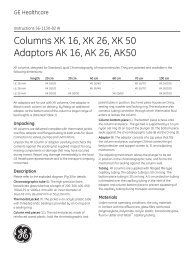
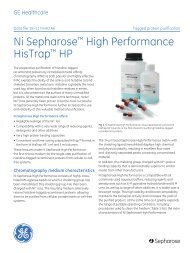
![[PDF] Sample preparation for analysis of protein, peptides and ...](https://img.yumpu.com/21549715/1/190x257/pdf-sample-preparation-for-analysis-of-protein-peptides-and-.jpg?quality=85)
![[PDF] Data File: rProtein A Sepharose Fast Flow](https://img.yumpu.com/21549316/1/190x253/pdf-data-file-rprotein-a-sepharose-fast-flow.jpg?quality=85)
![[PDF] MBP-tagged protein purification](https://img.yumpu.com/21548507/1/184x260/pdf-mbp-tagged-protein-purification.jpg?quality=85)
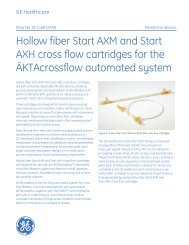
![[PDF] AKTA ready system Data file](https://img.yumpu.com/21540925/1/190x253/pdf-akta-ready-system-data-file.jpg?quality=85)
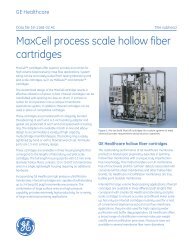
![[PDF] Data File - rProtein A/Protein G GraviTrap](https://img.yumpu.com/21539052/1/190x253/pdf-data-file-rprotein-a-protein-g-gravitrap.jpg?quality=85)
